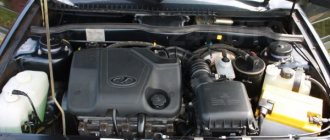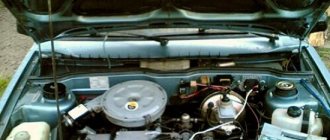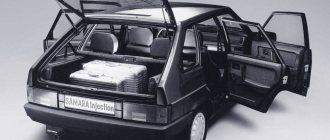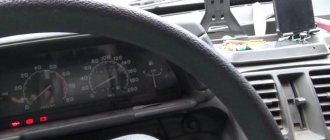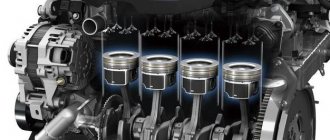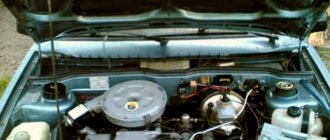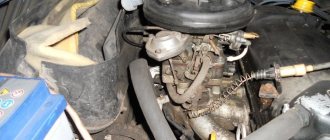Reasons for tripling
Strong engine vibrations are the first symptom of tripping. At the same time, misfires, exhaust problems and other symptoms may occur. Troubleshooting can be permanent or appear occasionally; it can appear during heavy engine loads or during different temperature conditions.
Engine failure during tripping is distinguished primarily by the fact that the combustion process of fuel assemblies in the cylinders is disrupted. Accordingly, this is accompanied by strong vibrations. However, it is fundamentally wrong to consider the appearance of increased vibrations as the only sign of tripling, since there are a number of reasons when the same thing happens.
Trouble engine injector causes
The main problems that contribute to tripling include the following.
- Excessive air in the system.
- Rich FA.
- Problems with the ignition system.
- Wear of engine elements, which is accompanied by a drop in compression.
Thus, the power unit begins to triple as a result of either a mismatch in the composition of the fuel assembly, or untimely ignition of the mixture, or the inability to ignite the fuel. Other types of violations are also possible.
To determine the specific cause of tripling, you need to narrow the search, thereby leaving the only correct reason.
- They usually start with the fuel system. The air supply is then analyzed. In some cases, this is caused by the failure of certain sensors.
- Ignition failure is an equally common cause of power unit tripping. Added to this is a weak spark from the spark plugs. It is recommended to always check the latter as soon as tripping or other ignition-related problems occur. The candles are simply unscrewed and inspected for defects, their color is analyzed, etc. For example, if the insulator of a candle is damaged, then smoke is clearly visible in this place.
- Armor wiring testing. If the engine shakes occasionally in wet weather, this is generally an additional symptom that shows tripping due to wires. The signs go away as soon as the engine warms up and reaches its operating temperature. It is recommended to pay special attention to rubber insulators, which tend to dry out and crack over time.
Attention . Rubber caps for armored wiring often deteriorate after repair work. It can be difficult to visually determine a breakdown until the cap is removed.
Gray smoke with a blue tint from the exhaust
Gray or blue smoke usually indicates an oil problem. Often, blue smoke from the exhaust pipe is observed in cars whose engines “take oil.” The blue or gray color itself occurs as a result of oil entering the combustion chamber and its subsequent combustion. Excess oil in the combustion chamber indicates wear of parts of the cylinder-piston group; these could be: problems with valve stem seals, worn rings or problems with the cylinders themselves, as well as problems in the crankcase ventilation system. The appearance of blue smoke will one way or another be accompanied by increased engine oil consumption, decreased compression, and a drop in engine power.
I note that blue smoke is not always the wear of the piston rings; it can also be a “stagnation” as a result of their coking. I advise you to familiarize yourself in more detail with the term “engine coking”, as well as how to decoke it.
Brake booster failure
The vacuum brake booster (VUT) of the VAZ 2109 is not formally related to the operation of the cylinders. But failure of the VUT can lead to failure of the third cylinder. The engine will start to stall.
The vacuum booster is designed to reduce the force on the brake pedal required to effectively slow down the vehicle. To do this, VUT uses rarefied air, which it takes from the intake manifold. The intake hose fitting, equipped with a check valve, is located near the combustion chamber of the third cylinder. It is this cylinder that stops working if the amplifier fails or if the supply hose is damaged.
Due to the damage, atmospheric air is sucked in, the mixture becomes leaner, and ignition does not occur. Often, malfunctions in the operation of the brake pedal are accompanied by a significant increase in the force on the brake pedal; it becomes “dull” and does not provide proper deceleration. It happens that when you press the brake pedal, the engine stops revving and runs normally, but when you release the pedal, the third cylinder fails again. All of these are sure signs of a VUT malfunction, and they require your immediate response.
White smoke from the exhaust
As I already said, in the cold season, on almost any car you can see white smoke from the exhaust, which is not a sign of a malfunction and does not require any action on the part of the owner. The white smoke from the exhaust will disappear as soon as it warms up.
If thick white smoke comes out of the exhaust and the temperature outside is above zero, this is a reason to think about it. Most likely, antifreeze gets into the cylinders, and there are cracks or leaking gaskets in the cylinder head itself.
Ignition
The car is tripping the injector due to the module
The ignition module is a unit that comes into question after all the checks have been carried out. It is the bobbin that can become the culprit for the power unit tripping at idle or in other modes. To check the coil you need to do this:
- Unscrew the spark plug, then apply it to the ground (any part of the body).
If the spark is good, its color is of high quality, and a characteristic crackling sound is heard, then the serviceability of the reel is not questioned. On the contrary, if there is no spark, or it is of poor quality, the module must be replaced, and thus it will be possible to “cure” the tripping.
It's not very often that a switch goes bad, but it does happen. It must be checked and, if anything, replaced.
Air supply
Excess air or lack of it is the reason that causes engine tripping. Occurs due to the system losing its tightness. The power unit begins to suck in air, the electronics do not take this process into account, and as a result, the functioning is disrupted.
Injector nozzles
Everyone will be able to check the air system, since there is nothing complicated in the procedure.
- The inlet hose located near the air filter is blocked.
- Pressure is created in the system.
- The location of the leak is checked by reducing the pressure.
It is clear that if the pressure does not drop, then the system is completely sealed. On the contrary, if the air comes out with a hiss, then this will not only verify the leakage, but also determine the specific location of the leak.
As for the lack of air, this is due to a dirty air filter. The latter loses its capacity. What should be done. Remove the filter and evaluate the operation of the power unit without it. If there is no difference, then the air filter is not doing its job at all and needs to be replaced.
Insufficient air may also be due to throttle problems.
It is also important to clean and check it in a timely manner. It is advisable to carry out the procedure during each scheduled maintenance, simultaneously with the replacement of filters, oil, etc.
d.
Injector temperature sensor
As mentioned above, the cause of engine tripping on the injector can be sensors. They send impulses to the electronic unit. If the signal is erroneous, then the electronics are not able to correct it. For example, if information is received that the engine is cold, but it has been running for an hour, the electronics will send an order to the injectors to inject enriched fuel assemblies. As a result, tripping and a lot of other troubles will arise, including in cold weather.
Why does the engine of a VAZ 2109 car troit?
The reason that troit 2109 occurs is uneven combustion of fuel in a single cylinder. The reasons for this may be:
- The ignition timing is set incorrectly.
- There has been a malfunction in the vacuum corrector system for ignition distribution or in the carburetor accelerator pump.
- The spark plugs have become unusable.
- A high-voltage wire has broken.
- Capacitor failure.
- There is a leak in the intake manifold or carburetor.
- Burnt pistons or valves.
- The piston rings are broken.
- Valves incorrectly adjusted.
- The gasket in the cylinder head has broken.
- Worn, hardened or broken.
- Use of very low quality fuel.
- The carburetor is not adjusted correctly.
- The distributor shaft and the rotary plate bearing are worn out.
- The membrane of the vacuum ignition accelerator has lost its tightness.
- There are other reasons why the engine of the VAZ 2109 troits.
Advice : You can determine which cylinder has stopped working by removing the high-voltage wire from the spark plugs one by one, but the work must be done very carefully so as not to cause an electric shock. Place a wooden or rubber stand under your feet, take only clean and dry rags, remove them only by holding the wire, but not the cap, do not touch the car body during manipulation. To check, you need to increase the idle speed to 1500 rpm using a choke and remove the spark plug caps one by one. A drop in engine speed indicates the serviceability of the cylinder; there are no deviations - the cylinder does not work.
Elimination methods
It is worth understanding that tripling on a carburetor power unit will occur not only while driving, but also at idle speed. In this case, the motor will make sounds like popping noises. But the car will twitch only while driving. So, it’s worth going directly to the analysis of the process of diagnosing and troubleshooting.
Carburetor
Unlike injection engines, a carburetor is a rather finicky thing that is sensitive to fuel and the technical condition of parts. Therefore, many motorists know that the power unit can stall precisely because of the carburetor. This version of the car was equipped with an injection element marked Solex, with which many are familiar.
To cure the shaking and jerking of the car, you will have to sort out and clean the carburetor. The cleaning process occurs manually or using a special oven that heats the cleaning liquid. But, as practice shows, most car enthusiasts who clean carbs with their own hands do the process completely manually.
Calibration data for the carburetor installed on VAZ 2108, VAZ 2109, VAZ 21099 vehicles
After the carburetor has been rebuilt, it needs to be adjusted. Adjustment is carried out using quality and quantity screws until the optimal ratio of fuel supplied to the chamber for forming the air-fuel mixture is achieved.
Fuel
If for an injection engine the poor quality of fuel is even more or less tolerable and you can drive, then for a carburetor engine it is a disaster. Bad fuel not only clogs the jets, but also quickly damages the fuel pump.
Poor quality gasoline can be identified immediately, since the engine begins to “chug”, traction disappears, and if you open the float chamber of the carburetor, the liquid called gasoline will be sticky and will not pass through the nozzles well.
To eliminate the problem, you will have to disassemble and clean the entire fuel system, including the removal of the fuel tank. After cleaning, you need to fill in, albeit expensive, but high-quality gasoline and drive 50-60 kilometers to clean the valve mechanism and piston group.
Fuel pump and filter
Another reason that the engine starts to stall is an insufficient or intermittent supply of fuel to the carburetor. In this case, the problem will lie precisely in the fuel pump or a dirty filter element.
Therefore, it is recommended to check these elements for functionality. If necessary, repair the fuel pump and replace the fuel filter.
Spark
A missing spark is a sign of a malfunction of the ignition system. Namely, spark plugs, wires or a coil could have failed. Spark plugs are checked on a special spark plug stand, but if there is none, then it is necessary to inspect the elements for damage, measure gaps and resistance. If a malfunction is detected, replace damaged parts.
During the diagnostic process, high-voltage wires are measured for resistance and also inspected for damaged insulation. If you find that one or more wires are broken, they should be replaced. The new wire should have a resistance of 5 ohms.
Air filter
The air filter has repeatedly caused the tripping effect. So, this element must be changed every 20,000 km. It is untimely replacement that leads to problems with the formation of the air-fuel mixture.
The term troit engine VAZ 2109 means
The term “troit engine” appeared in the era of automotive development, when vehicle power plants were equipped with four-cylinder engines. If, for one reason or another, the working cylinder stopped functioning, then three cylinders remained in operation, which during operation made a characteristic sound, as if the engine was stalling in a damped mode.
Engine compression measurement for VAZ 2109
Subsequently, despite the complication of the design of the piston group and the increase in the number of cylinders, the term “troit engine” remained in use among car enthusiasts.
Let's sum it up
If your nine stalls immediately after it starts and does not want to idle, then first of all you need to check:
- Is the ignition system working?
- Is the power system working?
First, make sure that you haven’t run out of fuel (yes, that happens). If there is gasoline in the tank, open the hood and do a visual inspection of the engine and carburetor. Make sure all the wires are in place (at least none of them are loose or burnt). The rburetor, fuel pump and gasoline hoses also need to be carefully examined. If gasoline leaks somewhere, you can’t drive any further, you can’t even start the car. It is best to use the services of a tow truck. It is also necessary to check whether the oil level in the engine meets the established standards (look at the dipstick marks) and the antifreeze level. To superficially check the adequate operation of the ignition system, you need to check the contacts. An ohmmeter is used for this. If everything is normal, the device will show zero resistance. Otherwise, you will have to replace the contact group or the entire ignition switch. The most important thing is to remain calm if the car stalls while driving. Remember to turn on your hazard lights and try to stop slowly and smoothly (or pull over to the side of the road) so as not to interfere with other road users.
How to understand that the VAZ 2109 engine is troit?
The concept of “engine tripling” was invented by motorists themselves. It is associated with the design and operation of four-cylinder internal combustion engines. If one of the four cylinders failed, the internal combustion engine still continued to operate on the three remaining cylinders. But such a failure was distinguished by a characteristic sound, which was called “engine tripping” - functioning on only three cylinders. In this case, the fuel mixture in the idle cylinder will not burn as expected, but will accumulate.
If you do not respond to such a failure in the system in time, the fuel mixture will be diluted with oil, enter the crankcase with oil and dilute it thinner and thinner. In this case, the oil will lose its lubricating functions, which will lead to rapid wear of the rings, cylinder-piston group and other important parts of the car. A little later, the engine will have to be repaired not partially, but completely.
Similar failures occur in the VAZ-2109. They can be recognized by their characteristic features:
- The engine in idle mode manifests itself with periodic twitching, unevenly.
- When driving, the VAZ-2109 does not gain the required power.
- The car moves jerkily.
- If you press the gas pedal, failures in engine operation will be detected.
- An uneven exhaust comes out of the muffler, which is interrupted and accompanied by popping noises.
Fault options.
The most common malfunction is that the charging indicator light does not go out. If the control lamp continues to burn brightly, then the voltage regulator is faulty or the wire from the control lamp to the generator is shorted to ground. If the control lamp continues to light, but not at full intensity, and lights up brighter as the speed increases, then there is a current leak through one of the additional diodes of the rectifier bridge. At the same time, the generator performs its function, charging the battery and powering consumers.
To check, you need to measure the voltage at the battery terminals with the headlights on high beam and rpm 1200 - 1500. If the voltage is more than 13.5V, then the generator is working and if the lamp burning at full intensity does not irritate, then you don’t have to do anything. Otherwise, you will have to change the diode bridge.
If the voltage is below normal, then disconnect the thin wire from the generator with the engine off and the ignition on. If the control lamp does not go out, then it is necessary to find and eliminate the wire short to ground. If the warning light goes out, then with the engine running, connect the free terminal to terminal 30 (a contact bolt with two thick wires). If charging appears, then eliminate the loss of voltage in the contacts from the control lamp to the generator.
If charging still does not appear, turn off the ignition and remove the brush assembly with voltage regulator from the generator, if the design of the generator allows it, or remove the generator completely and remove the regulator. Check the removed regulator using a test lamp and battery. How to do this is described in the article “Checking the voltage regulator.” If the regulator is working, then it is necessary to remove and repair the generator. The most common malfunction in this case is wear of the armature slip rings. It is also possible that the wire from the slip rings may break.
Main reasons and their definition
When the engine in a VAZ 2109 stalls, the sound of the running engine acquires a characteristic timbre, where elements of vibration and rattling can be heard, and the engine power unit does not gain speed and operates unstable.
Breakdown of high-voltage wires of the VAZ 2109 is one of the reasons why the VAZ engine may start to fail
At the same time, the engine speed is unstable, its operation is not uniform, it makes sounds as if the engine is overcoming some invisible obstacle. The muffler emits intermittent exhaust with an uneven period of exhaust emission.
Causes of unstable engine idling
Most often, a situation arises when the engine stalls at idle speed. Moreover, it makes no difference whether this happens when it’s cold or when it’s hot. There can be many reasons for this, ranging from a simple spark plug failure to malfunctions in the piston group of the internal combustion engine. While it is very easy to replace a spark plug, wear on the cylinders in the block can lead to a major overhaul.
Most often, the engine does not operate stably at idle in the following cases:
- The valves are not adjusted (clamped);
- The timing belt is installed incorrectly (the marks do not match);
- The IAC is faulty;
- The cylinder head valves are bent or burnt out (the valves can bend during a water hammer when a large amount of water gets into the air filter housing);
- The piston burned out;
- There is a malfunction in the electronic engine control system. The sensors, the ECU itself, electrical wiring and I/O wires may be to blame here.
There are many options for why the car idles at idle, but there are still the most basic ways to determine faults.
Reasons why an unheated VAZ 2109 engine fails
Soot on the VAZ 2109 spark plugs indicates the presence of a poor fuel-air mixture (another reason why the VAZ 2109 engine suffers)
It often happens that a VAZ 2109 stalls when cold, but as it warms up the engine levels out and starts working stably. There could be several reasons:
- The ECU sets the fuel mixture too rich to cold;
- The spark plug does not work, but when heated, the spark plug still “breaks through”;
- The high-voltage wires are damp or moisture has entered the ignition coil;
- Parts of the piston group are worn out.
Rich mixture
The engine began to stall and stopped developing maximum power. When cold it may start and stall. In this case, the air-fuel mixture is to blame, where there is a lot of fuel and little oxygen.
It floods the spark plugs with gasoline and they refuse to work. From this you can judge the quality of the fuel mixture. If there is black soot, it is rich, if it is light, it is poor.
I wrote about this in detail in other articles, go to the channel, everything is written there, the link was above.
What to do
Look for the reason. There are several possible sources of problems:
- Mass air flow sensor
. It fails and the ECU receives incorrect readings for preparing the mixture. I wrote how to check it here. - The second lambda was covered with a “copper basin”
. There is also a separate article about it. - In the case of a carburetor, a high level in the float chamber
.
And so on. There can be many reasons for a rich mixture. If you are interested, I will write a separate article on this topic. Let me know about it in the comments.
What to do and what to pay attention to
In order to determine why the engine in a VAZ 2114 is misfiring, you must follow the recommendations of professionals. First of all, you need to determine which cylinder is out of order, for this you need to:
- open the hood with the engine running;
- remember the sound and nature of the operation of the power plant;
- remove the high-voltage wires from the spark plugs one by one, if the sound and rhythm of operation changes, then continue further, as soon as it is discovered that when the spark plug is de-energized, the nature of the sound does not change, which means the faulty cylinder has been identified.
Next, you need to unscrew the spark plug and determine its condition and performance.
It is unscrewed using a special spark plug wrench, which is recommended to be carried with you in an emergency kit. It takes up little space, but is a unique key that cannot be replaced and can come in handy at the most unexpected time. After all, even simply by replacing a heavily carbonated spark plug with a new one, you can temporarily solve the problem with starting the engine.
The next step is to determine the condition of the removed spark plug. If the electrode is intact and clean, and there is a large amount of soot on the head, then with a high degree of probability it can be determined that dust has entered the combustion chamber of the cylinder, therefore the fault must be looked for in the air supply system through the air filter.
If the entire head, along with the electrode, is covered in smoke, and it is severely burnt out, it means that a lean mixture was supplied and detonation combustion occurred with ignition advance. When the head is also completely covered with smoke and the electrode is in good condition, this means that a rich mixture was supplied and there was a delay in the ignition supply.
Ignition coil module VAZ 2109
Assessing the condition of the spark plug gives direction in finding the true cause of cylinder failure. However, you should also check the performance of the candle itself. There is a proven method for this - “by spark”. If a spark breaks through, even if weak due to carbon deposits, then you must definitely look further. But if there is no spark at all, then you should replace the spark plug with a new one and check it. If there is a good spark, you can try to start the car and monitor the dynamics of changes.
If the car has a fairly high mileage, then trying to find the reason why the engine is shaking, you must do the following:
- change the spark plug;
- change the set of high-voltage wires; during prolonged operation under conditions of high temperatures and voltages, microcracks appear on the shell, leading to breakdowns and failure; experienced auto electricians recommend periodically changing this set for prevention;
- measure the compression in the idle cylinder; if it is broken, then perhaps the rings are stuck or the valves are burnt out;
- adjust the valves, this procedure should be carried out for prevention every 15 - 20 thousand kilometers;
- determine the performance of the ignition coil, this is a fairly common failure, the best solution is to replace the old one with a new one;
- change the air filter;
- Check that the timing belt is installed correctly.
All the specified procedures have been completed, but the engine still “troubles”. We need to move on:
- Conduct diagnostics of the electronic control unit and replace if necessary.
- Check the fuel supply system, down to the injectors.
- Determine the performance of the oxygen sensor, if it is faulty or produces deteriorated indicators - repair or replace.
- The failure of the crankshaft position sensor is determined by the computer, and an error should be generated indicating a breakdown. If this happens, replace it.
Black smoke
One of the most dangerous types of breakdowns is engine and fuel system malfunctions, which are accompanied by black smoke from the exhaust pipe.
Here are other signs that may appear:
- Fuel consumption increases significantly, the smoke is very thick and dark, and therefore quite toxic.
- The engine is unstable and sometimes stalls.
- There is a loss of engine power.
- The engine starts very poorly.
Why is this happening? This malfunction is typical for VAZ due to the presence of a carburetor. Due to a malfunction of the needle valve, overflow occurs in the float chamber. This problem also occurs when the air jets are clogged. It is worth cleaning them and replacing parts, adjusting the fuel supply system or the entire engine.
Checking the engine at idle
Faulty VAZ 2109 ECU (burnt-out transistor unit)
If you notice that the VAZ-2109 engine starts to stall at idle, then you need to check the following systems:
- Fuel supply system.
- Ignition system.
- Valve system.
In the first case, if the faults are in the fuel supply system, then the first step is to flush the fuel system, and then clean the injectors using ultrasound.
The second case involves problems with the ignition system. Therefore, perform the following actions:
- change spark plugs;
- check the functionality of the ignition coil;
- update the set of high-voltage wires.
In the third case, the valves are closely dealt with, that is, they should be adjusted so that they perform their functions properly. If this cannot be done, the old valves are simply replaced with new ones.
Other smoke sources
There are a number of other problems that cause smoke from the engine:
- Cooling system malfunction. The parts overheat and partially burn, and smoke is released.
- Failure of the fuel supply system. In addition, the fuel may not burn completely, resulting in exhaust gases of a different color.
- Coolant or oil enters the engine cylinders due to damage in them.
It is impossible to list all the possible problems that could cause smoke to come out of your car. Basically, replacing parts, oil or fuel is enough to fix the problem, but sometimes the cause of the breakdown cannot be found out on your own.


